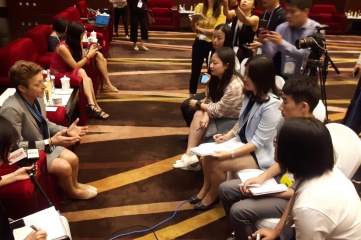“There are two different pathways to develop sport. One is to create successful heroes – athletes like Yang Yang, who you had the honour of interviewing just now – and they will inspire youngsters, kids, the media, sponsors to create a lot of interest in the sport.
“The other way is mass participation, through activity. We are working on both solutions, both opportunities at FIS. On the one side organising competitions here in China, which will continue right through with the big progression plan to the 2022 Olympic winter games and long afterwards. This is having a great effort from the Chinese sports authorities to build up new champions to have a lot of success. That will inspire more youngsters, activity and participants.
“On the other side we have developed programmes to get into snow sports. For nearly 10 years the ‘Bring Children to the Snow’ programme has created a lot of interest in China, as well and “Snow Kids” activity and with the annual ‘Snow Day’ since 2012. And now here together with the WWSE in Beijing we will launch the ‘Get Into Snow Sport China’. This is an entrants level course designed to for people to be able to really begin being familiar with snow, learning the basics, enjoying having fun and making friends with snow sports. That’s what it’s all about.
“We are working with the Chinese Ski Association, with Beijing Sport University, with the institutions here in China and commercial partner Alisports to be able to market a course all over the country and create a lot of interest and really make it happen. So there are two ways; champions and getting kids started who have perhaps never seen snow before.
“The goal for the next generation is to have many happy and health new sports participants and, we hope, champions at future events.”
New events at Beijing 2022
“There are many opportunities to include new events. The philosophy of the IOC however is to ensure that the Games remain manageable, that there is not an over-explosion of new facilities required, so that can be many different countries and regions that are capable of hosting the Olympic Winter Games also in the future. So within the six FIS disciplines, we have an excellent blend of traditional sports and young sports and we are able to develop and adapt the disciplines and the events on the programme as society changes, as also the different opportunities – technology, skill, equipment, facilities – and this is exactly what we are doing.
“For Beijing 2022 we are looking at different opportunities. In ski jumping for example, like “friends from Biathlon”, we have a mixed team event for the ski jumping with ladies and men in one team – it’s part of the World Championships since many years. We are also proposing the inclusion of Nordic combined for ladies, which is also an activity we have within FIS, not yet at Olympic level. It will be on the programme of the Youth Olympic Games in Lausanne in 2020.
“We are looking to add to the Big Air competition for snowboards, which will be at this fantastic new venue in Shougang in Beijing. Not only snowboard but also to have Ski Big Air, like we have in the World Cup. And, on proposal of Chinese Ski Association and Chinese Olympic Committee, they will also submit a bid to have mixed team aerials.
“So there are some interesting opportunities across the difference disciplines within FIS that the IOC will be asked to evaluate and to consider if they will bring additional value to the Olympic Winter Games.”
This article, composed of statements Sarah Lewis OBE made to the press at World Winter Sports Expo in Beijing, first appeared in the Winter 2017 issue of Host City magazine


